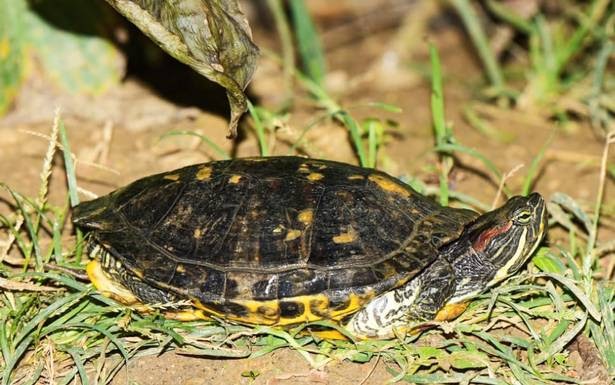Red-Eared Slider Turtle
Why in News
The invasive red-eared slider can become a major threat to the biodiversity of water bodies across the Northeast region of India.
- The Northeast region of India is home to more than 72% of the turtle and tortoise species in the country.
Key Points
- About:
- Scientific Name: Trachemys scripta elegans
- Habitat: U.S. and northern Mexico
- Description: The red-eared slider derives its name from red stripes around the part where its ears would be and from its ability to slide quickly off any surface into the water.
- Popular Pet: This turtle is an extremely popular pet due to its small size, easy maintenance, and relatively low cost.
- Reason for Concerns:
- Invasive Species: Since it is an invasive species they grow fast and virtually leave nothing for the native species to eat and have a negative impact on the areas and the species living in the areas they invade.
- Catch-22 Situation: People who keep the turtle as pets become sensitive about turtle conservation but endanger the local ecosystem, probably unknowingly, by releasing them in natural water bodies after they outgrow an aquarium, tank or pool at home.
- Impact on Human Health: They can impact human health when these species may accumulate toxins in their tissues which pass on with the food chain upto humans.
Invasive Species of India
- An invasive species is an organism that causes ecological or economic harm in a new environment where it is not native.
- There are many invasive species in India. For eg: Charru Mussel, Lantana bushes, Indian Bullfrog, etc.
International Instruments and Programmes on Invasive Species
- Cartagena Protocol on Biosafety (2000):
- The Protocol seeks to protect biological diversity from the potential risks posed by Living Modified Organisms resulting from modern biotechnology.
- Convention on Biological Diversity (CBD):
- It was one of the key agreements adopted at the 1992 Earth Summit in Rio de Janeiro.
- The Rio de Janeiro Convention on Biodiversity (1992) had also recognised the biological invasion of alien species of plants as the second-worst threat to the environment after habitat destruction.
- Article 8 (h) of the Convention calls on Parties to prevent the introduction of, control or eradicate those alien species which threaten ecosystems, habitats or species.
- It was one of the key agreements adopted at the 1992 Earth Summit in Rio de Janeiro.
- Convention on the Conservation of Migratory Species (CMS) or Bonn Convention (1979):
- It is an intergovernmental treaty that aims to conserve terrestrial, marine and avian migratory species throughout their range.
- It also aims to control or to eliminate already present invasive alien species.
- Convention on International Trade in Endangered Species of Wild Fauna and Flora (CITES):
- It is an international agreement adopted in 1975 that aims to ensure that international trade in specimens of wild animals and plants does not threaten their survival.
- It also considers the problems of invasive species when it is involved in trade and threatens the survival of live animals or plants.
- Ramsar Convention (1971):
- The Ramsar Convention on Wetlands of International Importance is an international treaty for the conservation and sustainable use of wetlands.
- It also addresses the environmental, economic and social impact of invasive species on wetlands within their jurisdictions and to take account of the methods of control and solutions for combating invasive species.
